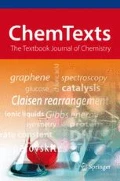Abstract
The lecture lesson starts with a brief review of freeze-drying history, its scientific basics, and numerous applications. Freeze drying is also a new effective method to prepare solid analytical standards, which is superior to the conventional methods blending and spiking. The freezing process in liquid nitrogen is completed in fractions of a second. Hence, the original homogeneous distribution of the dopants is preserved and the subsequent sublimation step minimizes any disturbance. Freeze-dried standards exhibit superior lateral distribution and uniform depth distribution. Tungsten standards obtained by freeze-drying aqueous solutions of doped highly soluble ammonium metatungstate showed an outstanding degree of homogeneity. Various tungsten standards doped with 10–28 elements ranging from 10 to 200 ppm each were successfully used as controls for a number of analytical techniques including glow discharge mass spectrometry and DC ARC optical emission spectroscopy. Molybdenum standards prepared by freeze-drying aqueous solutions of doped slightly soluble ammonium paramolybdate, revealed, however, some degree of segregation. Compared to standards prepared by the conventional methods, the freeze-dried standards were still superior. By introducing the starting mixture into liquid nitrogen as a mist, the homogeneous distribution of the dopants was significantly improved.












Similar content being viewed by others
Abbreviations
- ADM:
-
Ammonium dimolybdate
- AMT:
-
Ammonium metatungstate
- APM:
-
Ammonium paramolybdate
- DC-ARC-OES:
-
Direct-current-arc optical emission spectroscopy
- EDS:
-
Energy dispersive X-ray spectroscopy
- GDMS:
-
Glow discharge mass spectrometry
- GTP:
-
Global Tungsten & Powders Corporation
- HFSW:
-
High-frequency square wave
- ICP:
-
Inductively coupled plasma
- LMS:
-
Laser mass spectrometry
- MS:
-
Mass spectrometry/mass spectrometer
- NIST:
-
National Institute of Standards and Technology
- PC/PLC:
-
Personal computer/programmable logic controller
- ppm:
-
Parts per million
- rf:
-
Radio frequency
- rpm:
-
Revolutions per minute
- SEM:
-
Scanning electron microscope
- SIMS:
-
Secondary ion mass spectrometry
- SNMS:
-
Sputtered neutral mass spectrometry
- XPS:
-
X-ray photoelectron spectroscopy
References
Connelly A (2017) Preparation of calibration standards. https://andyjconnelly.wordpress.com/2017/03/06/preparation-of-calibration-standards/
Dang TA, Hilliard C (1999) Factors influencing the quantitative compositional analysis of powders in sputtered neutral mass spectrometry. J Vac Sci Technol A 12:2348–2351
Bowen VT, Volchok HL (1980) Spiked sample standards; their uses and disadvantages in analytical quality control. Environ Intern 3:365–376
Dang TA, Lunk HJ, Roychowdhury S, Frisk TA, Bard TJ, Fassett HO, Nached AS (2009) A novel method for preparation of solid standards. 17th Intern Plansee Seminar, Reutte/Austria, in Sigl LS, Rödhammer P, Wildner H (eds) Proceedings, vol 3 AT3:1–9
Dang TA, Lunk HJ, Roychowdhury S, Frisk TA, Bard TJ (2010) Characterization of solid standards prepared by freeze-drying. Surf Interface Anal 42:45–51
Dang TA, Lunk HJ, Otis JS, Bard TJ (2013) Freeze-dried molybdenum solid standards: preparation and characterization. 18th Intern Plansee Seminar, Reutte/Austria, in Sigl LS, Kestler H, Wagner J (eds) Proceedings RM 33:331–344
Meryman HT (1976) Historical recollections of freeze-drying. Dev Biol Stand 36:29–32
Corver J (2009) The evolution of freeze-drying. Innovation Pharm Technol 29:66–70. http://iptonline.com/articles/public/IPT_29_p66non%20print.pdf
Gutcho MH (1977) Freeze drying processes for the food industry. Noyes Data Corp., Park Ridge, New Jersey
Ratti C (2001) Hot air and freeze-drying of high-value foods: a review. J Food Eng 49:311–319
Franks F (2007) Freeze-drying of pharmaceuticals and biopharmaceuticals: principles and practice. Thomas Graham House, Science Park, Milton Road, Cambridge, RSC Publishing
Ciurzyńska A, Lenart A (2011) Freeze-drying—application in food processing and biotechnology—a review. Pol J Food Nutr Sci 61:165–171
Harris RJC (ed) (1954) Biological applications of freezing and drying. Academic Press Inc., Publishers, New York
Barley J Basic principles of freeze drying. https://www.spscientific.com/freeze-drying-lyophilization-basics/
AMERICANLyophilizer General principles of freeze drying. http://freezedrying.com/freeze-dryers/general-principles-of-freeze-drying/#1
Lyophylization (2010) Abnova, YouTube https://www.youtube.com/watch?v=-INsuz3H1M0
Kusay R (1972) Metallurgy and metal forming 377–378
El-Himri A, Núñex P, Sapiña F, Ibáñez R, Beltrán A, Martínez-Agudo JM (2004) Synthesis of new molybdenum–tungsten, vanadium–tungsten and vanadium–molybdenum–tungsten oxynitrides from freeze-dried precursors. J Solid State Chem 177:2423–2431
Xi X, Nie Z, Yang J, Fu X, Wang W, Zuo T (2005) Mater Sci Eng A 394:360–365
Xi X, Nie Z, Yang J, Fu X, Wang W, Ji D, Zuo T (2006) Preparation and characterization of nanopowder for emission materials by freeze-drying. Int J Refract Met Hard Mat 24:210–214
Xi X, Nie Z, Yabao J, Peiyun T, Shunlin S, Jie X, Tieyong Z (2008) Synthesis and characterization of ultrafine Ni–Co composite powder by freeze-drying. J Alloys Compounds 466:387–390
Materials Standards Materials Catalogue (2015) https://www.sigmaaldrich.com/content/dam/sigma-aldrich/docs/Sigma-Aldrich/Brochure/1/nist-standard-reference-materials-catalogue-rtp.pdf
Armour AW, Hallada CJ, Mulholland KA, Brochure Preparation of Molybdate Solutions, Climax Molybdenum Company (USA), http://www.climaxmolybdenum.com
Dang TA, Frisk TA (1998) Depth resolution advantages of plasma sputtering in depth profiling of conductive and non-conductive materials. Surf Coat Technol 106:60–65
Ammonium metatungstate solubility. http://www.ctia.com.cn/Marketing/2017/146395.html
Mikhailov VL, Gazimzyanov NR (1993) Thermolysis of ammonium hexamolybdenumnickelate. Zh Neorg Khim (in Russian) 38:119–121
Lee U, Joo HC, Kwon JS (2002) Tetraammonium hexahydrogen hexamolybdonickelate(II) tetrahydrate, (NH4)4[H6NiMo6O24]·4H2O. Acta Cryst E58:i6–i8. https://doi.org/10.1107/S1600536801021109
Author information
Authors and Affiliations
Corresponding author
Additional information
Tuan A. Dang and Hans-Joachim Lunk retired from Global Tungsten & Powders Corp., Towanda, PA, 18848 USA.
Rights and permissions
About this article
Cite this article
Dang, T.A., Lunk, HJ. Freeze drying: a novel method for preparation of solid analytical tungsten and molybdenum standards. ChemTexts 4, 11 (2018). https://doi.org/10.1007/s40828-018-0066-z
Received:
Accepted:
Published:
DOI: https://doi.org/10.1007/s40828-018-0066-z




